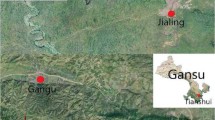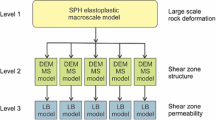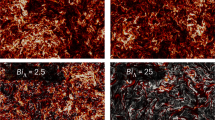Abstract
In structural geology, viscous creep is generally recognized as the major deformation mechanism in the folding of rock layers through geological time scales of hundreds of thousands of years. Moreover, since deformation of rock salt by creep takes already place on relatively small time scales—weeks to months, say—creep is a relevant phenomenon when studying salt mining, notably the convergence of mine cavities and the land subsidence caused by it. While creep is the dominant process on relatively long time scales, elasticity plays a dominant role in processes that take place on relatively short time scales. The elastic response to a stress is a displacement; the shape of the rock is deformed instantaneously with respect to its initial shape. However, the viscous response of a rock to a stress is a relatively low velocity in the order of millimeters per months or years, say. In this paper we consider the two deformation phenomena creep and elasticity. In general, elasticity is a compressible phenomenon, while creep is incompressible. Here we approximate creep by the introduction of a negligibly small amount of compressibility, which makes creep velocity calculations similar to conventional elastic displacement calculations. Using this procedure, a standard finite element package for elasticity can be applied to viscous problems, also in combination with elasticity. The method has been demonstrated to upscaling of creep viscosities.
Similar content being viewed by others
References
Auriault, J. L., and Bonnet, G., 1987, Surface effects in composite materials: two simple examples: Int. J. Engin. Sci., v. 25, no. 3, p. 307–323.
Batchelor, G. K., 1973, An introduction to fluid dynamics: Cambridge University Press, Cambridge, 615 p.
Bensoussan, A., Lions, L.-L., and Papanicolaou, G., 1978, Asymptotic analysis for periodic structures: North Holland Publishing Company, Amsterdam, 200 p.
Davis, R. O., and Selvadurai, A. P. S., 1996, Elasticity and geomechanics: Cambridge University Press, Cambridge, 198 p.
De Witte, F. C., and Hendriks, M. A. N., 1998, DIANA: Finite element analysis, user’s manual release 7, linear static analysis: TNO Building and Construction Research, Delft, 260 p.
Duvaut, G., and Lions, J.-L., 1976, Inequalities in mechanics and physics: Springer-Verlag, Berlin, 397 p.
Fokker, P. A., 1995, The behaviour of salt and salt caverns: Ph.D. thesis, Delft University of Technology, 143 p.
Helbig, K., 1994, Foundations of anisotropy for exploration seismics: Elsevier Science, Inc., New York, 486 p.
Jeremic, M. L., 1994, Rock mechanics in salt mining: A. A. Balkema, Rotterdam, 532 p.
Johnson, A. M., and Fletcher, C., 1994, Folding of viscous layers: Columbia University Press, New York, 461 p.
Lamb, H., 1974, Hydrodynamics: Cambridge University Press, Cambridge, 738 p.
Postma, G. W., 1955, Wave propagation in a stratified medium: Geophysics, v. 20, no. 4, p. 780–806.
Ranalli, G., 1995, Rheology of the earth: Chapman & Hall, London, 413 p.
Rijpsma, G., and Zijl, W., 1998, Upscaling of Hooke’s law for imperfectly layered rocks: Math. Geol., v. 30, no. 8, p. 943–969.
Spiers, C. J., and Carter, N. L., 1998, Microphysics of rocksalt flow in nature, in Aubertin, M., and Hardy, H.R., eds., The mechanical behaviour of salt, Proc. 4th conf. series on rock and soil mechanics, 22: TTP Trans Tech Publications, Clausthal-Zellerfeld, p. 115–128.
Zienkewicz, O. C., and Taylor, R. L., 1967, The finite element method: MacGraw-Hill, London, 648 p.
Zijl, W., Hendriks, M. A. N., and ‘t Hart, M., 2002. Numerical homogenization of the rigidity tensor in Hooke’s law using the displacement-based conformal-nodal finite element method: Math. Geol., v. 34, no. 3, p. 291–322.
Zijl, W., and Trykozko, A., 2001, Numerical homogenization of the absolute permeability using the conformal-nodal and mixed-hybrid finite element method: Transport Porous Media, v. 44. p. 33–62.
Author information
Authors and Affiliations
Corresponding author
Rights and permissions
About this article
Cite this article
Zijl, W., Hendriks, M. & Hart, M. A Velocity-Based Approach to Visco-Elastic Flow of Rock. Math Geol 37, 141–162 (2005). https://doi.org/10.1007/s11004-005-1306-5
Received:
Accepted:
Issue Date:
DOI: https://doi.org/10.1007/s11004-005-1306-5




